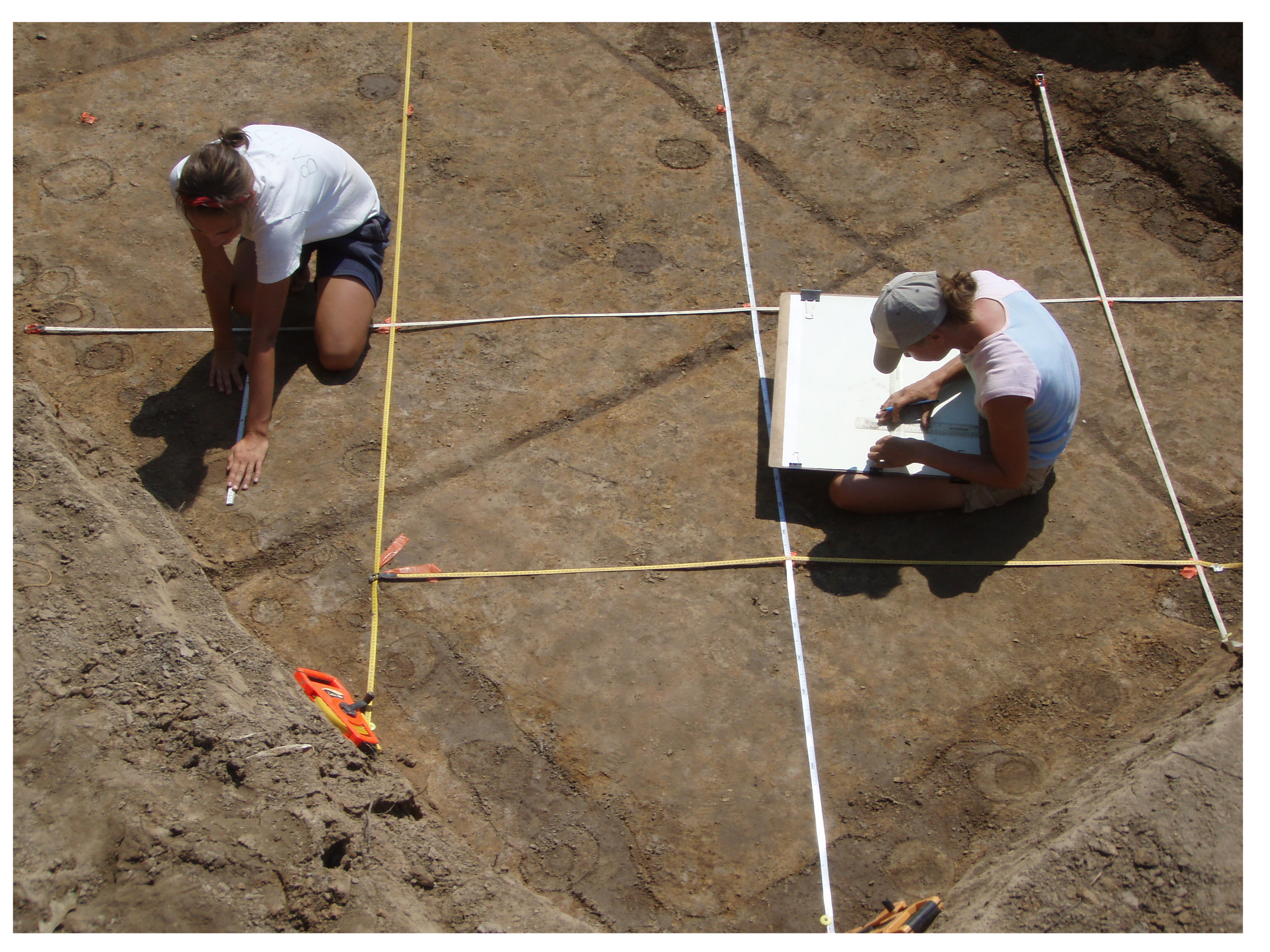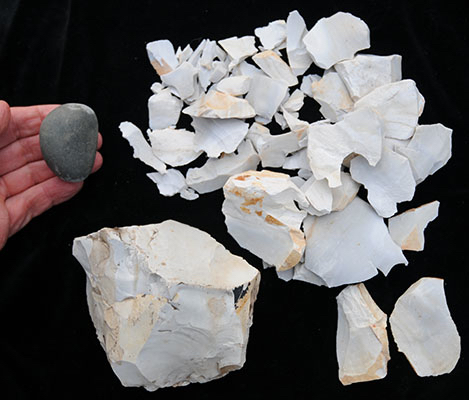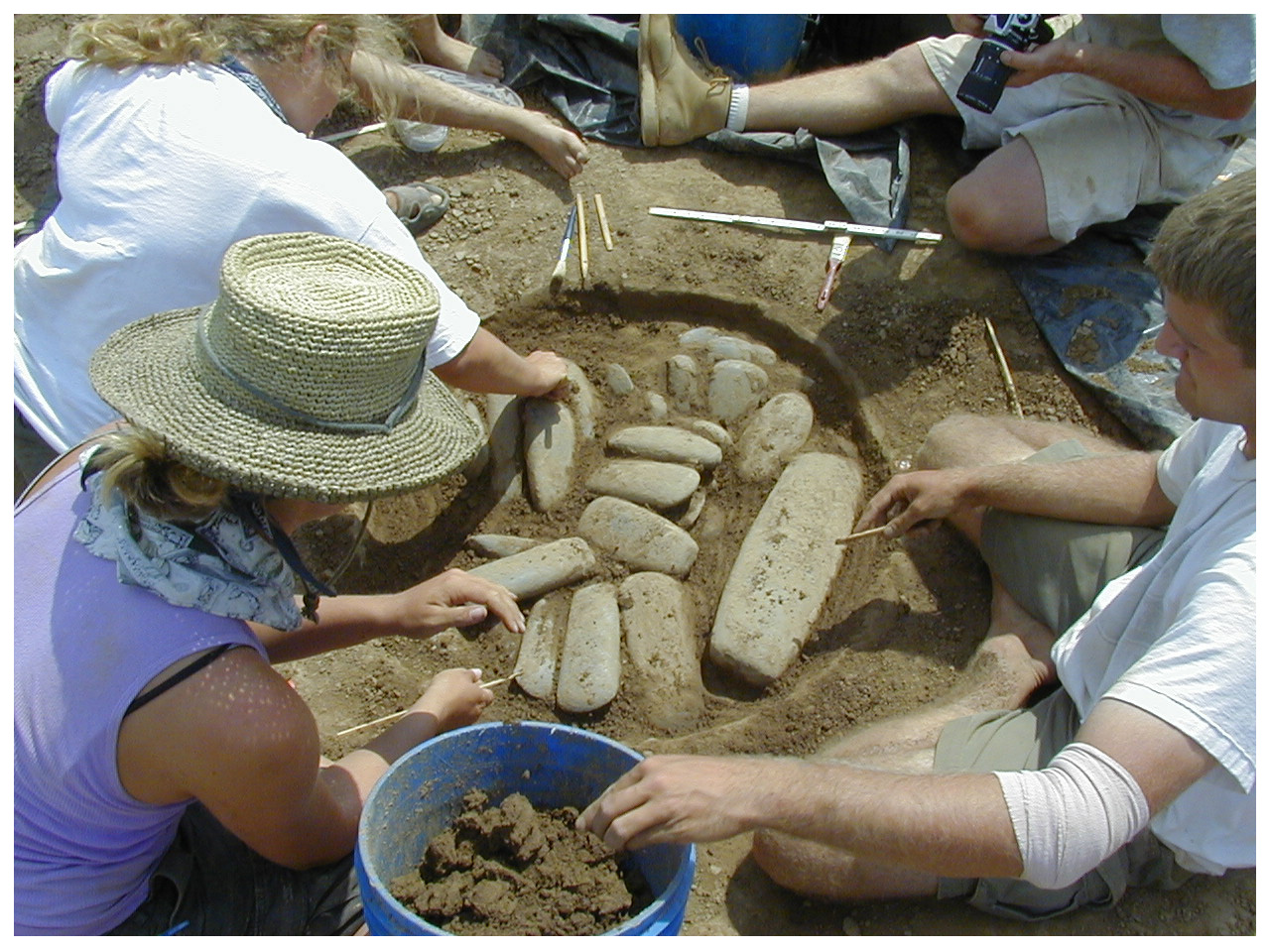Richland Project
Cahokia’s dramatic mid-11th century CE construction as a monumental capital, built by a diverse, rapidly urbanizing population of immigrants and locals, is a model for the rise of early civilizations everywhere. This is especially true because the precise causal connections between immigrant farmers, climate change, and religion can be understood thanks to eight highly productive salvage-archaeological field excavations at four sites east of the American Indian city of Cahokia. Each field season was conducted under emergency salvage conditions in a part of the greater St. Louis region witnessing rapid 20th-century development and each saw large-scale excavations at four sites dating to 1050-1100 CE, Cahokia’s critical founding phase that witnessed dramatic, urbanizing change.
Understanding the fundamental relationships between cultural diversity, agriculture, climate, religion and social history is being realized by correlating multiple lines of domestic, culinary, and ritual evidence associated with the remains of hundreds of pole-and-thatch buildings and other discrete deposits excavated at the four sites under salvage conditions in the 1990s and 2000s. The people at each site ran the gamut from local to immigrant and farmer to administrator. The question that the Richland Analysis Project seeks to answer is this: how did producers from diverse social and cultural backgrounds underwrite civilization?Understanding how, especially the extent to which people’s choices and relationships to ecological, political, ancestral, and other elemental powers are filtered by their worldviews, has a direct bearing on questions of global sustainability into our collective future. By isolating the region’s discrete subpopulations and tracking their activities around 1050 CE, we are generating the needed historically detailed understanding of how new agrarian relationships linked farming and farmers with other forces of the world in ways that underwrote Cahokia’s urbanism.
We ask the following series of nested research questions of our datasets:
How culturally diverse were the farmers?
- What culinary, technological, and isotopic indicators of diverse origins exist?
- Compared to Cahokians, what did people’s lives consist of?
- Were farmers routinely involved in Cahokian affairs, producing materials or craft goods for gifting or exchange? If so, how?
- Did periodic ritual events take place that might provide details on local or regional community building?
- How ubiquitous are ritual pots, plants, animal remains and other deposits?
- What did they receive from outside their village?
- How were settlements founded and for how long and in what ways did they last?
- Were all houses permanent domiciles?
- Was the landscape opened for large-scale agriculture at the beginning?
- How was the abandonment of the four sites connected to regional social, political or agricultural and climatic changes?
- Did their exodus precede and possibly give rise to the late 12th century construction of fortifications at Cahokia?
- Did abandonment correlate with field exhaustion or dry periods?
The larger relevance of answers to these questions lies less in knowing whether or not non-elites affect the course of human history. Most anthropologists, sociologists, and historians today would agree that they do. However, understanding how they do, especially the extent to which people’s choices and relationships to ecological, political, ancestral, and other elemental powers are filtered by their worldviews or ontologies, has a direct bearing on questions of global sustainability and international relations in the future. Such early-agriculturalist ways-of-relating-to-the-world can be understood by observing the repeated and ritualized associations of human life and death with plants, animals, tradition and landscapes, all of which are recoverable in the material remains of ancient farmers (see Methods, below).

 To address research question #1 above, culinary remains and bone-isotopic data are being studied. In addition, at least two non-local lithic technologies and one culinary practice (cooked dog) have been observed in the materials from the sites that, if closely correlated with the pottery-vessel modes, will act to bolster inferences about the cultural diversity of these farmers. Research question #2, characterizing people’s lives in economic, identity, and ontological terms, will be answered primarily using density and ubiquity indices of non-vessel remains from domestic features. Tabulations of materials from year 1 at the Halliday site, for instance, revealed high densities of agricultural-tool lithic refuse and expended spindle whorls. These suggest limited but intensive production of crops and yarn in ways that need to be verified and compared to the other site data in order to determine if this was done at levels beyond local village needs. Complementing these data will be faunal and floral evidence of dietary and ritual practices. Little in the Halliday-site material assemblages indicates supra-community ritual or Cahokian relationships (although the central courtyard includes a Cahokia-style medicine lodge and buildings with plastered floors). This contrasts markedly with the contemporary Grossmann, Hal Smith, and Pfeffer sites, just two, three, and nine km away, respectively. Household and community-scale ritual activity seems prominent there, with Grossmann and Pfeffer argued to be a “ritual outpost” and “shrine complex,” respectively.
To address research question #1 above, culinary remains and bone-isotopic data are being studied. In addition, at least two non-local lithic technologies and one culinary practice (cooked dog) have been observed in the materials from the sites that, if closely correlated with the pottery-vessel modes, will act to bolster inferences about the cultural diversity of these farmers. Research question #2, characterizing people’s lives in economic, identity, and ontological terms, will be answered primarily using density and ubiquity indices of non-vessel remains from domestic features. Tabulations of materials from year 1 at the Halliday site, for instance, revealed high densities of agricultural-tool lithic refuse and expended spindle whorls. These suggest limited but intensive production of crops and yarn in ways that need to be verified and compared to the other site data in order to determine if this was done at levels beyond local village needs. Complementing these data will be faunal and floral evidence of dietary and ritual practices. Little in the Halliday-site material assemblages indicates supra-community ritual or Cahokian relationships (although the central courtyard includes a Cahokia-style medicine lodge and buildings with plastered floors). This contrasts markedly with the contemporary Grossmann, Hal Smith, and Pfeffer sites, just two, three, and nine km away, respectively. Household and community-scale ritual activity seems prominent there, with Grossmann and Pfeffer argued to be a “ritual outpost” and “shrine complex,” respectively.
 Research question #3 deals with the processes of founding, permanence, and agricultural landscape modification within the Richland Complex. A thorough chronological analysis of each site is refining our preliminary sense that all sites were founded at or very shortly after 1050 CE. Moreover, our radiocarbon assays from all four sites are being correlated with new hydroclimatic and soil data to evaluate an inference that dryland farming of the Richland Complex’s tall grass prairie would have proven highly productive during relatively wet periods, particularly for maize, owing to its high nitrogen concentrations resulting from natural and human-induced cycles of fire that burn N-fixing prairie plants.
Research question #3 deals with the processes of founding, permanence, and agricultural landscape modification within the Richland Complex. A thorough chronological analysis of each site is refining our preliminary sense that all sites were founded at or very shortly after 1050 CE. Moreover, our radiocarbon assays from all four sites are being correlated with new hydroclimatic and soil data to evaluate an inference that dryland farming of the Richland Complex’s tall grass prairie would have proven highly productive during relatively wet periods, particularly for maize, owing to its high nitrogen concentrations resulting from natural and human-induced cycles of fire that burn N-fixing prairie plants.
To address research question #4, the relationship of site abandonment to regional change, a new hydroclimatic sequence has been developed to which the terminal deposits of each site (readily identified through patterns of house reconstruction and stratigraphy) is being compared. A postulated early 12th century shift back to drier conditions may have reduced the productivity of the Richland area while it enhanced that of the Cahokia-area floodplain. Social tensions could have resulted leading, ultimately, to farmers abandoning the Richland Complex. Based largely on preliminary observations, all sites appear to have been abandoned in the early 12th century, with the Grossmann site possibly lasting to 1150 CE.